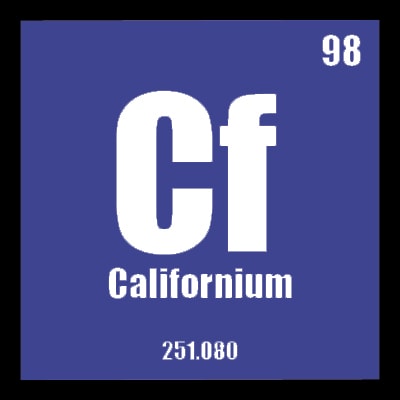This element was first discovered in 1950 at the University of California Radiation Laboratory in Berkeley.
Since that time, Californium-252 has been used as a neutron source in applications such as nuclear reactor start-up and neutron spectroscopy. It has also found use in the oil industry, as well as gold and silver prospecting.
Properties
As a strong neutron emitter, this isotope is a hazardous material to handle, and is rarely found in nature, due to its very short half-life. Some of its properties are:
- Silver-white and metallic in appearance, with a melting point of approximately 900°C. It is malleable and can be cut using a razor blade.
- The material has a half-life of 2.645 years and is a strong neutron emitter, meaning it is extremely radioactive, and not normally found in nature.
- One microgram of Cf-252 can release 170 million neutrons every minute. This presents significant radioactive hazards to the human body, and proper safety measures should be strictly enforced when handling the material.
Applications
Californium can be used in several applications in different industries. Because of its high radioactivity, these applications typically draw on information gathered from the material’s neutron emissions.
Some applications include:
- Reactor Start-Up – As a neutron source, this material is especially suited for use as a neutron source to assist in the starting of nuclear reactors. When loaded with fresh fuel, the stable emission of neutrons from the material initiates nuclear chain reactions.
- Oil Industry – The oil industry uses this element for its neutron emissions in the process of well logging. Neutron moisture gauges include the material to help locate layers of water and petroleum in oil wells, giving drilling operations a better understanding of the ground they are drilling.
- Material Scanning – Penetration of neutrons into different materials means that Cf-252 can be used in several types of detection equipment. Fuel rod scanners ensure safe operation in nuclear facilities, while radiographs of components in aircraft and weapons can detect defects such as poor welds, corrosion, or cracks.
Hazards
Because of its strong neutron emissions, this isotope is extremely radioactive, and health hazards need to be considered when handling the material.
In the case of Cf-252, the material can enter the body through ingestion and can be inhaled through element particles suspended in the air. Inside the body, 65% will deposit on the skeleton, 25% in the liver, and the rest in other organs or excreted.
The ionizing radiation from the material on the bone and in the liver can cause cancer. It can also cause external tissue damage through gamma ray emission. Once deposited in the body, it can take 50 years to be removed from the skeleton, and 20 years to be removed from the liver.



